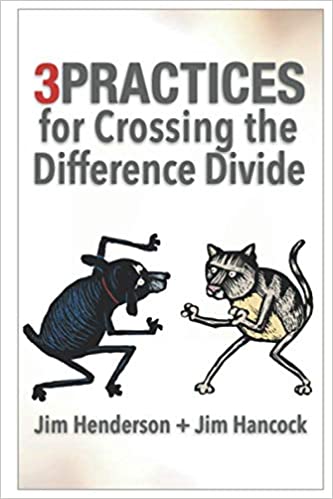by Jim Henderson, Jim Hancock

Learn more and purchase here:
“3Practices for Crossing the Difference Divide” is for people who are sad, angry, and apprehensive about important relationships being sucked into the vortex of the difference divide. It’s a book for people who aren’t ready to accept this as our new normal — where we have no choice but to write off relationships that mean a great deal to us. Americans are distancing themselves from loved ones, avoiding family gatherings, dropping out of religious congregations, parting ways over social norms, breaking up over politics. It doesn’t have to be this way, but at the moment this is exactly how it is. And, if we don’t change directions, it’s exactly how things will remain. Jim Henderson and Jim Hancock spent a lot of energy learning to create spaces where folks come to understand each other without being obliged to agree. They’re convinced that anyone with a hunger for renewing and strengthening human connections can set the table for others who want that too. And, of course, they’re not alone. The 2018 Hidden Tribes Report — Hidden Tribes: A Study of America’s Polarized Landscape — found that “77 percent of Americans believe our differences are not so great that we cannot come together.” The unanswered question is “How do we do that?” The 3Practices are a map across the difference divide. — Practice One: I’ll be Unusually Interested in others — Practice Two: I’ll stay in the room with difference — Practice Three: I’ll stop comparing my best with your worst.3Practice Circles are how we find people who are willing to go the distance. This book is about practicing the Practices in the safety of a controlled environment so people can take them home — and to work, school, and anywhere they’re likely to encounter people who hate what they love and love what they hate. The 3Practices are not about waving the white flag. They’re not about compromising principled convictions. They don’t even depend on finding agreement. 3Practice Circles are about reaching clarity and understanding and choosing to connect or protect, depending on what’s warranted. The future is not in the rearview mirror. Henderson and Hancock have no interest in returning to a time when things seemed harmonious, but only at the cost of so many voices ignored, excluded, or silenced. “The world is complicated,” they write. “We share space with neighbors who may never agree on things that matter a great deal. But how about creating a collaborative future with those folks anyway? How about learning to work alongside people of good will who can disagree, loud and late into the night, without wishing each other dead or incapacitated?” If the notion of working to create that sort of future strikes a chord in you, let’s do it together.”3Practices for Crossing the Difference Divide. – Jim Henderson + Jim Hancock
